

R′
III.2.2 Overview of the Suzuki
Protocol with B
AKIRA SUZUKI
A. INTRODUCTION
Carbon–carbon bond-formation reactions are the most important processes in organic chemistry. Until almost a half century ago, a number of the C—C bond-formation reactions were reported using organic molecules with sp3-C atoms, but there were no general direct methodologies for carbon – carbon bond formation between unsaturated species such as vinyl, aryl, and alkynyl moieties. The discovery of metal-catalyzed crosscoupling reactions, starting in the early 1970s, overcame the difficulties and such reactions were noted as the most powerful and useful synthetic tools.[1]
Among metal-mediated cross-coupling reactions, the Pd-catalyzed cross-coupling reaction between different types of organoboron componds and various organic elec- ' trophiles such as halides and triflates in the presence of base provides a powerful and general methodology for the formation of C—C bonds. The coupling reaction offers several advantages: ready availability of reagents, mild reaction conditions, water stability, toleration of a broad range of functional groups, good regioand stereoselectively, insignificant effect of steric hindrance, small amount of catalysts, application in one-pot synthesis, nontoxic reaction, and easy separation of inorganic boron compounds.[2]–[5] The overview of the boron-coupling reactions is mentioned in this section.
B. COUPLING OF 1-ALKENYLBORON COMPOUNDS:
SYNTHESIS OF CONJUGATED DIENES
The stereoand regioselective syntheses of conjugated alkadienes are of great importance in organic chemistry by themselves as well as their utilization in other reactions such as the Diels–Alder reaction. A number of new methods for the preparation of conjugated dienes and polyenes have been developed by utilizing various organometallic reagents. Among these procedures, the most promising ones are perhaps those based on the direct cross-coupling reaction of stereodefined alkenylmetals with stereodefined haloalkenes in the presence of a transition metal complex.[2] However, there are several limitations when one wishes to obtain unsymmetrical dienes without homocoupling, highly functionalized dienes, or stoichiometric conditions relative to metal reagents and organic halides. Thus,
Handbook of Organopalladium Chemistry for Organic Synthesis, Edited by Ei-ichi Negishi ISBN 0-471-31506-0 © 2002 John Wiley & Sons, Inc.
249
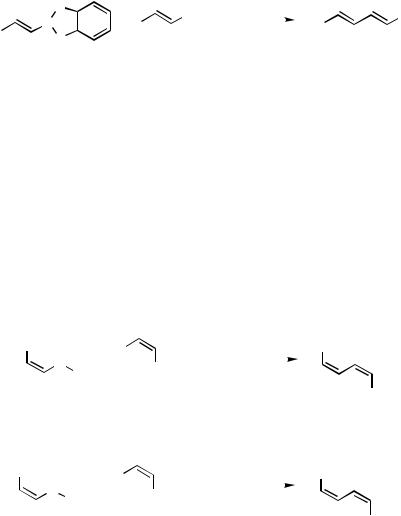
250 |
III Pd-CATALYZED CROSS-COUPLING |
much attention has recently been focused on the use of 1-alkenylboron compounds, because a variety of 1-alkenylboron derivatives are now readily available. The first observation to prepare conjugated dienes is shown in Scheme 1.[6] ,[7]
|
O |
|
Pd(PPh3)4 (1 mol %) |
|
|
|
Ph |
NaOEt (2 equiv) |
|
Ph |
|
B |
|
+ Br |
benzene/reflux/2 h |
nBu |
|
nBu |
O |
|
|
||
|
|
|
|
|
|
y(yield): 86% ip(isomeric purity): >98%
Scheme 1
The high yield of the diene is obtained when relatively strong bases such as sodium ethoxide and hydroxide are used with a phosphine-based Pd complex, for example, Pd(PPh3)4 and PdCl2(PPh3)2. As 1-alkenylboron compounds, disiamyland 9-BBN derivatives can be utilized in the coupling reactions. However, the coupling of such (Z )-1- alkenylboron reagents with 1-alkenyl halides gives insufficient results in yield and stereo-selectivity. One such result is shown in Scheme 2.[8] The difficulty is surmounted by using diisopropoxyboron derivative instead of disiamylor dicyclohexylboron compounds. Consequently, all kinds of conjugated alkadienes are able to be synthesized by the cross-coupling reaction regioand stereoselectively in high yields under suitable reaction conditions.
nBu |
|
|
|
|
|
Pd(PPh3)4 (3 mol %) |
|
Sia |
|
Br |
|
|
nBu |
||
|
|
|
+ |
|
NaOEt (2 equiv) |
|
|
|
|
|
|
||||
|
B |
Sia |
|
Hexn |
benzene/reflux/3 h |
||
|
|
|
|
|
|
|
|
Hexn
y: 49% ip: >98%
nBu |
|
|
OPri |
|
|
Pd(PPh3)4 (3 mol %) |
nBu |
|
|
+ |
Br |
NaOEt (2 equiv) |
|||
|
|||||||
|
B |
Hexn |
benzene/reflux/3 h |
|
|||
|
i |
|
|||||
|
|
|
OPr |
|
|
|
|
Hexn
y: 87% ip: >98%
Scheme 2
This reaction was applied to the synthesis of many alkadiene structures including complex natural products such as palytoxin,[9] chlorothricolide,[10] and rutamycin B.[11] A new synthesis of vitamin A with essentially complete control of regioand stereochemistry has recently been reported.[12]
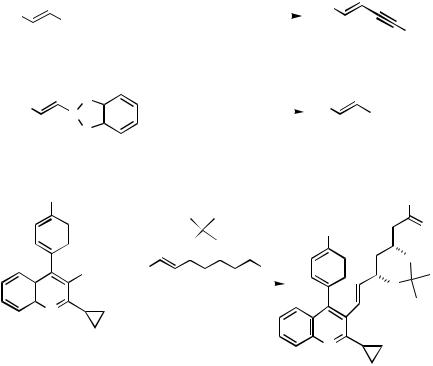
III.2.2 OVERVIEW OF THE SUZUKI PROTOCOL WITH B |
251 |
The cross-coupling reaction of 1-alkenyl(disiamyl)boranes with 1-bromo-1-alkynes gives conjugated enynes in high yields (Scheme 3).[7] The cross-coupling of 1-alkenyl- boronates is useful for alkenylation of haloarenes (Scheme 3).[13] The relative reactivity appears to be PhI p-ClC6H4Br PhBr o-MeC6H4Br o-MeOC6H4Br.[13] The order of reactivity is in good agreement with substituent effect in the oxidative addition of aryl halides to the Pd(0) complex. The procedure gives new access to HGM-CoA reductase inhibitor NK-104 (Scheme 4).[14]
nBu |
|
|
+ Br |
|
|
|
Hexn |
|
|
Pd(PPh3)4 |
|
nBu |
|
|||||
B(Sia)2 |
|
|
|
|
|
NaOMe/MeOH |
|
Hexn |
||||||||||
|
|
|
|
|||||||||||||||
|
|
|
|
|
|
|
|
|
|
|
||||||||
|
|
|
|
|
|
|
|
|
|
|
|
benzene/reflux |
|
|||||
|
|
|
|
|
|
|
|
|
|
|
|
|
|
|||||
|
|
|
|
|
|
|
|
|
|
|
|
|
|
|
|
|
|
y: 98% |
R |
|
O |
|
|
|
|
|
|
|
|
|
Pd(PPh3)4 |
R |
|
||||
|
B |
+ |
ArX |
|
|
Ar |
||||||||||||
|
|
|
|
NaOEt |
|
|||||||||||||
|
|
O |
|
|
|
|
|
|
|
|
|
|
|
|||||
|
|
|
|
|
|
|
|
|
|
|
benzene/reflux |
|
|
|||||
|
|
|
|
|
|
|
|
|
|
|
|
|
|
|||||
|
|
|
|
|
|
|
|
|
Scheme 3 |
|
|
|||||||
|
F |
|
|
|
|
|
|
|
|
|
|
|
|
|
|
|
OEt |
|
|
|
|
|
|
|
|
|
O |
O |
O |
F |
O |
||||||
|
|
|
|
|
|
|
|
|||||||||||
|
|
|
|
|
|
|
|
|
O |
|||||||||
|
|
|
|
|
|
|
|
|||||||||||
|
|
I |
|
(Sia)2B |
|
|
|
|
|
|
|
OEt |
|
|||||
|
|
|
|
|
|
|
|
|
|
|
|
|||||||
|
|
|
|
|
|
|
|
|
|
|
|
|
|
O |
||||
|
|
|
|
|
|
|
|
|
|
|
|
|
|
|
|
|
|
|
|
|
|
|
(Allyl)2Pd2Cl2/NaOEt/MeCN |
|
|||||||||||||
|
|
|
|
|
|
|||||||||||||
|
|
|
|
|
||||||||||||||
N
N
NK-104 y: 99%
Scheme 4
C. COUPLING OF ARYLBORON COMPOUNDS
The first method to prepare biaryl by the cross-coupling reaction between arylboron compounds and aryl halides was reported in 1981 in the presence of Pd(PPh3)4 and aqueous Na2CO3 in benzene at reflux temperature (Scheme 5).[15] After this discovery, various modifications were made for reaction conditions. A combination of Pd(PPh3)4 or PdCl2(PPh3)2 and aqueous Na2CO3 in dimethoxyethane (DME) works satisfactorily in most cases.[16] ,[17]
Phosphine-based palladium catalysts are generally used since they are stable on prolonged heating; however, extremely high coupling reaction rates can sometimes be achieved by using palladium catalysts without a phosphine ligand.[18]
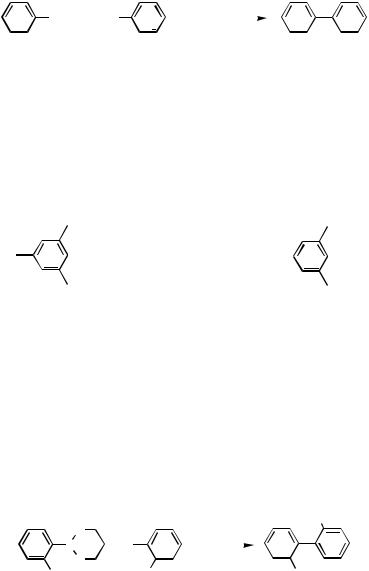
252 |
III Pd-CATALYZED CROSS-COUPLING |
|
|
|
|
|
|
|
|
||||||
|
|
|
B(OH)2 + X |
|
|
Pd(PPh3)4 |
|
|
|
|
|
|
|
||
|
|
|
|
|
|
|
|
|
|
|
|
||||
|
|
|
aq. Na2CO3 |
|
|
|
|
|
|
|
|||||
|
|
|
|
|
|
|
|
|
|
|
|
|
|
|
|
|
|
|
|
|
|
|
|
|
|
|
|
|
|
|
|
|
|
|
|
Z |
benzene/reflux |
|
|
|
Z |
||||||
Scheme 5
Although steric hindrance of aryl halides is not a major factor for the formation of substituted biaryls, low yields resulted when ortho-disubstituted arylboronic acids were used. For example, the reaction with mesitylboronic acid proceeds slowly because of steric hindrance during the transmetallation to Pd(II) halide. The addition of strong bases, for example, aqueous NaOH or Ba(OH)2, both in benzene and DME exerts a remarkable effect on the acceleration of the coupling rate (Scheme 6).[19]
Pd(PPh3)4
 B(OH)2 + X-Ar
B(OH)2 + X-Ar 

 Ar
Ar
aq. Ba(OH)2
benzene/80 °C
ArX: 2-MeOC6H4I (80%), 2-ClC6H4I (94%), 2-bromonaphthalene (86%)
Scheme 6
Even if there is no great steric hindrance, the reaction under aqueous conditions gives undesirable results due to competitive deboronation. For instance, coupling of 2- formylphenylboronic acid with 2-iodotoluene at 80 °C using an aqueous Na2CO3 in benzene gives only 54% of the expected biaryl with the formation of benzaldehyde (39%). The yield can be improved to 89% by using the corresponding ester of the boronic acid and anhydrous K3PO4 suspended in DMF (Scheme 7).[19]
CH3
O |
|
|
|
Pd(PPh3)4 |
|
|
|
B |
+ I |
|
|
|
|
||
|
|
|
|
|
|
||
|
|
K3PO4 |
|
|
|||
O |
|
|
|
|
|
||
|
|
|
|
|
|||
CHO |
CH3 |
|
|
DMF/80 °C |
|
CHO |
|
|
|
|
|
|
|||
|
|
|
|
|
|
y: 89% |
|
|
|
Scheme 7 |
|
|
|||
The cross-coupling reaction of arylboronic acids is largely unaffected by the presence of water, tolerating a broad range of functionality and yielding nontoxic by-products. The reaction offers an additional great advantage of being insensitive to the presence of ortho- functional groups or heteroaromatic rings. An example is shown in Scheme 8.[20]
Most recently, the anti-HIV alkaloids michellamines A and B have successfully been synthesized by a double Suzuki-type cross-coupling reaction between a binaphthalene ditriflate and an isoquinolineboronic acid (Scheme 9).[21],[22]
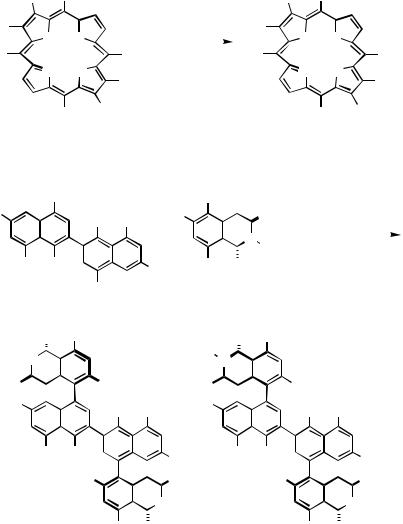
|
|
|
|
|
|
|
III.2.2 OVERVIEW OF THE SUZUKI PROTOCOL WITH B 253 |
|||||||||||||||
Br |
Ph |
|
|
|
|
|
|
|
|
|
Ar |
|
Ph |
|
|
|||||||
Br |
|
|
|
|
|
|
|
|
ArB(OH)2 |
Ar |
|
|
|
|
|
|
|
|||||
|
|
|
|
|
|
|
|
|
|
|
|
|
|
|
||||||||
|
|
|
|
|
|
|
|
|
|
|
|
|
|
|
||||||||
|
NH N |
|
|
|
|
|
|
|
|
|
|
|
NH |
N |
|
|
||||||
Ph |
|
|
|
|
|
Ph Pd(PPh3)4/K2CO3 |
Ph |
|
|
|
|
|
Ph |
|||||||||
|
N |
|
HN |
|
Br |
|
toluene/110 °C |
|
|
|
N |
HN |
Ar |
|||||||||
|
|
|
|
|
|
|
|
|
|
|
|
|
|
|
|
|
|
|
||||
|
|
Ph |
Br |
|
|
|
|
|
|
|
|
Ph |
Ar |
|||||||||
|
|
|
|
|
|
|
|
|
|
|
|
|
|
|
||||||||
|
|
|
|
|
|
|
|
|
|
|
|
|
|
|
|
|
y: 67−88% |
|
|
|||
|
|
|
|
|
|
|
|
|
|
Scheme 8 |
|
|
|
|
|
|
|
|
|
|||
|
OTf |
|
|
|
|
|
B(OH)2 |
|
|
Pd(PPh3)4/DME/H2O |
||||||||||||
Me |
|
|
|
|
|
|
|
|
BnO |
|
|
|
|
Me |
||||||||
|
|
|
|
|
|
OAc OMe |
+ |
|
|
N Bn |
Ba(OH)2/80 °C/8 h/74% |
|||||||||||
|
|
|
|
|
|
|
|
|||||||||||||||
|
|
|
|
|
|
|
|
|
|
|
|
hydrogenolysis |
|
|||||||||
|
|
|
|
|
|
|
|
|
|
|
|
|||||||||||
|
|
|
|
|
|
|
|
|
|
|
|
|
|
|
|
hydrolysis |
|
|
||||
MeO OAc |
|
|
|
|
Me |
BnO Me |
|
|
|
|
||||||||||||
|
|
|
|
|
|
atropisomer separation |
||||||||||||||||
|
|
|
|
|
|
|
|
|
|
|
|
|
|
|
||||||||
|
|
|
|
|
|
OTf |
|
|
|
|
|
|
|
|
|
|
|
|
|
|
||
|
Me |
|
OH |
|
|
|
|
|
|
|
Me |
|
OH |
|
|
|
|
|
|
|
||
HN |
|
|
|
|
|
|
|
|
|
Bn N |
|
|
|
|
|
|
|
|
|
|||
|
|
|
|
|
|
|
|
|
|
|
|
|
|
|
|
|
|
|||||
Me |
|
|
P |
OH |
|
|
Me |
|
M |
OH |
|
|
|
|
||||||||
|
|
|
|
|
|
|
|
|
||||||||||||||
Me |
|
|
|
|
|
|
|
Me |
|
|
|
|
|
|
|
|
||||||
|
|
|
|
|
OH |
OMe |
|
|
|
OH |
OMe |
|||||||||||
|
|
|
|
|
|
|
|
|
|
|
|
|
||||||||||
|
|
|
|
|
|
|
|
|
|
|
||||||||||||
|
|
|
|
|
|
|
|
|
|
|
|
|
|
|
|
|
|
|||||
MeO |
|
OH |
|
P |
|
Me |
MeO |
|
OH |
|
P |
|
|
Me |
||||||||
|
|
|
|
|
|
|
||||||||||||||||
|
|
|
|
|
||||||||||||||||||
|
|
|
|
|
|
|
|
|
|
|
|
|
|
|
|
|||||||
|
|
|
HO |
|
|
Me |
|
|
|
|
HO |
|
|
|
Me |
|||||||
|
|
|
|
|
|
|
|
|
|
|
|
|
|
|
|
|||||||
|
|
|
|
|
|
|
|
|
|
NH |
|
|
|
|
|
|
|
|
|
NH |
||
|
|
|
|
|
|
|
|
|
|
|
|
|
|
|
|
|
|
|
||||
|
|
|
|
|
|
|
|
|
|
|
|
|
|
|
|
|
|
|
||||
|
|
|
|
|
|
HO |
Me |
|
|
|
|
|
HO |
Me |
|
|
||||||
|
|
|
|
|
|
|
|
|
|
Scheme 9 |
|
|
|
|
|
|
|
|
|
|||
D. COUPLING OF ALKYLBORON COMPOUNDS
Although alkylmagnesium, -zinc, -tin, and -aluminum reagents have successfully been used for the cross-coupling reaction with organic halides, the reaction of alkylborane derivatives is particularly useful when one wishes to start from alkenes via hydroboration. Bases as well as palladium catalysts are essential for the success of the coupling reaction.[23],[24] A combination of PdCl2(dppf) and aqueous NaOH in THF works smoothly for most cases. Although strong bases accelerate the coupling reaction, weaker bases and aprotic conditions are desirable for functionalized alkylboron compounds or organic halides.
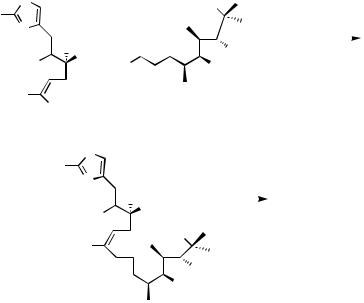
254 |
III Pd-CATALYZED CROSS-COUPLING |
Meng et al.[25] have recently reported a total synthesis of the promising anticancer agents epothilones A and B using alkylboranes coupling reaction as shown in Scheme 10.
Such a coupling reaction has been employed for the synthesis of many complex natural products and related compounds, for example, roflamycoin,[26] agelasimine A,[27] and azasugars.[28]
In contrast to stereochemical investigations of the related cross-couplings involving silanes and stannanes, the stereochemistry of the transmetallation of alkylboranes to palladium (either retention or inversion of configuration) has received little attention, although it was suggested to proceed with retention of configuration.[2]–[5] Recently, it has been confirmed that primary alkylboranes undergo transmetallation to palladium with retention of configuration.[29]
S |
|
|
(MeO)2HC |
||||
Me |
|
|
|||||
|
|
|
|
|
Pd(dppf )2 /AsPh3 |
||
N |
+ |
|
|
|
|||
|
|
|
|
|
|
||
|
H |
|
OTPS Cs2CO3/H2O/DMF |
||||
Me |
OAc |
|
|||||
R2B |
|
OTBS |
|||||
Me |
I |
|
|
|
|
|
|
|
|
|
|
|
|
||
|
S |
|
|
|
|
|
|
|
Me |
|
|
|
|
|
|
|
N |
|
several steps |
||||
|
|
|
|
||||
|
|
H |
|
|
|
(−)-Epothilone B |
|
|
|
|
|
|
|||
|
Me |
OAc |
|||||
|
|
|
|
|
|
||
|
|
(MeO)2HC |
|||||
|
Me |
|
|
|
|
|
|
|
|
|
OTPS |
||||
|
|
|
OTBS |
||||
y: 77%
Scheme 10
B-Alkylboron compounds react readily with various 1-alkenyl and aryl halides to give corresponding coupling products in high yields. However, it has been considered that such coupling reactions cannot be extended to alkyl halides with sp3-carbon having b-hydrogens due to the slow rate of oxidative addition of alkyl halides to Pd(0) complexes and the fast b-hydride elimination from s-alkylpalladium intermediates in the catalytic cycle. Thus, the use of alkyl halides as coupling partners was a challenging problem in several recent publications. Recently, it has been determined that the coupling reaction of usual iodoalkanes with 9-alkyl-9-BBN derivatives proceeds readily in the presence of Pd(PPh3)4 and K3PO4 in dioxane to provide the corresponding coupling products in reasonable yields (Scheme 11).[30]
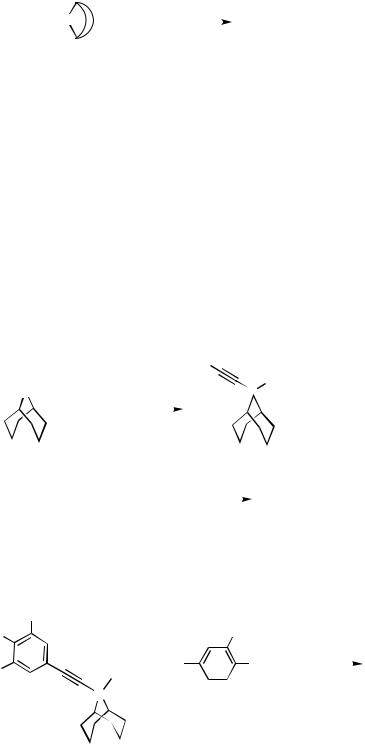
|
|
|
III.2.2 |
OVERVIEW OF THE SUZUKI PROTOCOL WITH B |
255 |
||||||
R |
|
B |
+ I |
|
R′ |
Pd(PPh3)4 |
R |
|
R′ |
|
|
|
|
|
|
|
|
||||||
|
K3PO4/dioxane |
|
|
||||||||
|
|
|
|
|
|
|
|
|
|
||
y : 55−71%
Scheme 11
E. COUPLING OF 1-ALKYNYLBORON COMPOUNDS
Alkynylboranes have long been known to be useful synthetic intermediates. Compared to other organoboranes, because they are stronger Lewis acids and are easily hydrolyzed, they have not been employed for the cross-coupling reaction, in which the presence of bases is essential. Most recently, Soderquist et al.[31] and Früstner and Seidel[32] have found independently that the addition of 9-methoxy-9-BBN to alkynylmetal reagents gives stable complexes (1) that undergo efficient Suzuki-coupling reactions to produce a variety of alkynyl derivatives (Scheme 12). The method is highly chemoselective and turned out to be compatible with aldehyde, amide, ketone, ester, and cyano functions as well as with basic nitrogen atoms in the substrates. This method was employed for the synthesis of combretastatin A-4 (Scheme 13).[33]
|
|
|
|
|
|
|
|
|
|
|
|
|
|
|
|
|
|
|
_ |
|
|
OMe |
|
|
|
|
|
|
|
R |
|
|
|
|
|
|
|
|
|
|
|||
|
|
|
|
|
|
|
|
|
|
|
|
OMe |
|
|
|
|
|||||
|
|
|
|
|
|
|
|
|
|
|
|
|
|
|
|
|
|
||||
B |
|
|
|
|
|
|
|
|
|
|
|
|
B |
|
|
Li+ |
|||||
|
+ R |
|
|
|
Li |
|
|
|
|
|
|
|
|
|
|
|
|
|
|
||
|
|
|
|
|
|
|
|
|
|
1 |
|
|
|
|
|
|
|
|
|||
|
|
|
|
|
|
|
|
|
|
|
|
|
|
||||||||
|
|
|
|
|
|
|
|
|
|
|
|
||||||||||
|
|
|
|
|
|
|
|
|
|
|
|
|
|
|
|
|
|
|
|
||
|
|
|
|
|
|
|
|
|
|
|
|
|
|
|
|
|
|
|
|
||
|
|
|
|
|
|
|
|
|
R′Br |
|
|
R |
|
|
|
|
|
|
R′ |
||
|
|
|
|
|
|
|
|
|
|
|
|
|
|
|
|
|
|
|
|
||
|
|
|
|
|
|
|
|
|
|
|
|
|
|
|
|
|
|
|
|
||
|
|
|
|
|
|
|
|
|
|
|
|
|
|
|
|
|
|
|
|
||
|
|
|
|
|
|
|
Pd(PPh3)4/no base |
|
|
|
|
||||||||||
|
|
|
|
|
|
|
|
|
|
|
|
R = Ar, alkyl |
|
|
|
|
|||||
|
|
|
|
|
|
|
|
|
|
|
|
R′ = Ar, 1-alkenyl |
|||||||||
|
|
|
|
|
Scheme 12 |
|
|
|
|
|
|
|
|
|
|
||||||
MeO |
|
|
|
|
|
|
|
|
|
|
|
|
|
|
|
|
|
|
|
|
|
MeO |
|
|
|
|
|
|
|
|
|
|
|
OSiMe2Bu |
|
|
|
|
|||||
|
|
|
|
|
+ Br |
|
|
OMe |
|
PdCl2(dppf) |
|||||||||||
MeO |
|
|
|
|
|
|
|
|
|
|
|||||||||||
|
|
|
|
|
|
|
|
|
|
||||||||||||
|
OMe |
|
|
|
|
|
|
|
|
|
|
|
|||||||||
|
|
|
|
|
|
|
|
|
|
|
|
||||||||||
B
Scheme 13
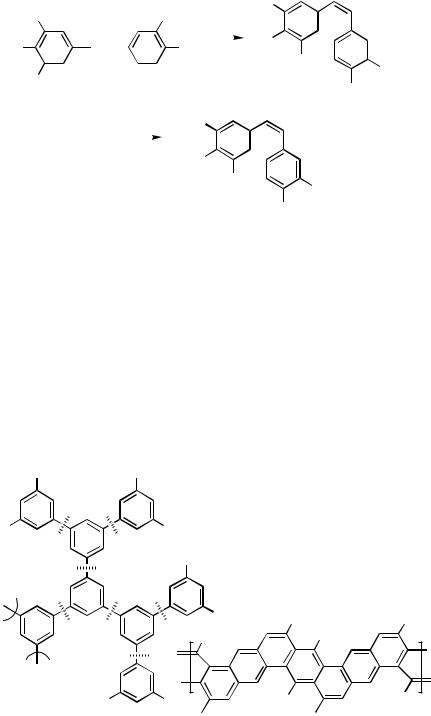
256 III Pd-CATALYZED CROSS-COUPLING
|
|
|
|
|
|
|
|
|
|
|
|
MeO |
||||
MeO |
|
|
|
|
|
|
|
|
OSiMe2Bu |
|
|
|
|
|||
|
|
|
|
|
|
|
|
|
||||||||
|
|
|
|
|
|
|
|
|
|
H 2 |
|
|
|
|
||
|
|
|
|
|
|
|
|
|
|
|||||||
|
|
|
|
|
|
|
|
|
OMe |
|
|
MeO |
|
|
||
MeO |
|
|
|
|
|
|
|
|
Pd/C |
|
|
|||||
|
|
|
|
|
|
|
|
|
||||||||
|
|
|
|
|||||||||||||
|
|
|
||||||||||||||
MeO |
|
|
|
|
|
|
|
|
|
|
|
MeO |
|
OSiMe2Bu |
||
|
|
|
||||||||||||||
|
|
|
|
|
|
|
|
|
|
|
|
|
|
|
||
|
|
|
|
|
|
|
|
|
|
|
|
|
OMe |
|||
|
|
|
|
|
|
|
|
|
|
|
|
|
|
|||
|
|
|
|
|
|
|
|
|
MeO |
|||||||
|
|
|
|
|
|
|
|
|
|
|
|
|
|
|
|
|
|
|
|
|
|
|
|
|
|
|
|
|
|
|
|
|
|
|
|
|
|
|
|
|
|
|
|
|
|
|
|
|
|
|
MeO
MeO
OH
OMe
Combretastatin A-4
Scheme 13 (Continued )
F. APPLICATIONS TO POLYMER CHEMISTRY
Aromatic rigid-rod polymers play an important role in a number of diverse technologies including high-performance engineering materials, conducting polymers, and nonlinear optical materials. The cross-coupling reaction of aryldiboronic acids and dihaloarenes for the synthesis of poly( p-phenylenes) was first reported by Rehahn et al.[34] The method has been extensively applied to water-soluble poly( p-phenylene),[35] planar poly( p- phenylenes) fixed with the ketoimine bonds,[36] poly(phenylenes) fused with polycyclic aromatics,[37] and nonlinear optical materials[38] (Scheme 14).
X |
X |
|
|
|
|
X |
|
X |
|
|
|
|
|
X |
|
|
|
|
|
X |
Ar |
Ar |
|
|
|
R |
R |
|
|
X = Br, COOH |
X |
X |
R |
R |
n |
|
|||||
|
|
||||
|
|
Ar |
Ar |
|
|
Hyperbranched polyphenylene |
Fused polycyclic poly(phenylene) |
|
|
||
|
|
Scheme 14 |
|
|
|
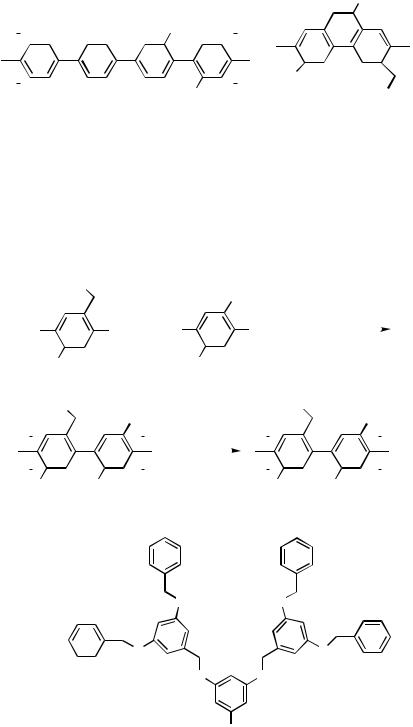
|
|
|
|
|
III.2.2 |
OVERVIEW OF THE SUZUKI PROTOCOL WITH B |
257 |
||||||||||||||||
|
|
|
|
|
|
|
|
|
|
|
|
|
|
|
|
|
R |
|
|
|
|
|
|
|
|
|
|
|
|
|
COOH |
|
|
|
|
|
|
|
|
|
|
|
|
|
|||
|
|
|
|
|
|
|
|
|
|
|
|
|
|
|
|
|
|
|
|
||||
|
|
|
|
|
|
|
|
|
|
|
|
|
|
|
|
|
|
|
|
||||
|
|
|
|
|
|
|
|
|
|
|
|
|
|
|
|
|
|
|
|
|
|
|
|
|
|
|
|
|
|
|
|
|
|
|
|
|
|
|
|
|
|
|
|
|
|
|
|
|
|
|
|
|
|
|
|
|
|
n |
|
|
N |
|
|
|
|
|
|||||
|
|
|
|
|
|
|
|
|
|
|
|
|
|
|
n |
|
|||||||
|
|
|
|
|
|
|
HOOC |
|
|
|
|
|
|
|
|
|
R |
|
|||||
|
|
|
|
|
|
|
|
|
|
|
|
|
R = C4H9, C12H25 |
|
|||||||||
|
|
Water-soluble poly( p-phenylene) |
Planar poly(p-phenylene) |
|
|||||||||||||||||||
|
|
|
|
|
|
Scheme 14 (Continued ) |
|
|
|
|
|
|
|
|
|
|
|
|
|
||||
Most recently, the preparation |
of ortho-polyphenylene oligomers, |
having |
three |
||||||||||||||||||||
to nine rings, using a rational Suzuki-coupling strategy, has been achieved.[39] Useful synthetic procedures for dendrimers are being investigated. Many such syntheses have been reported using Suzuki polycondensation. An example is shown in
Scheme 15.[40]
X
|
|
|
|
|
|
|
|
|
|
|
|
|
C6H13 |
|
|
|
|
|
|
|||||
Br |
|
|
Br + (HO)2B |
|
|
|
B(OH)2 |
cat. Pd(0) |
||||||||||||||||
|
|
|
|
|
|
|
|
|
|
|
||||||||||||||
|
|
|
|
|
Na2CO3/toluene |
|||||||||||||||||||
|
|
|
|
|
|
|
|
|
|
|
|
|
|
|
|
|
|
|
||||||
|
CH3 |
|
|
|
|
|
|
|
C6H13 |
|||||||||||||||
|
|
|
|
|
|
|
|
|
|
|
|
|
|
|||||||||||
|
|
X |
|
|
|
|
|
|
|
|
|
|
|
|
|
RO |
|
|
|
|
|
|
||
|
|
|
|
|
|
|
C6H13 |
|
|
|
|
|
|
|
|
|
|
C6H13 |
||||||
|
|
|
|
|
|
|
|
|
|
|
RY |
|
|
|
|
|
|
|
|
|||||
|
|
|
|
|
|
|
|
|
|
|
|
|
|
|
|
|
|
|||||||
|
|
|
|
|
|
|
|
|
|
|
|
|
|
|
|
|
|
|
|
|
|
|
|
|
|
|
|
|
|
|
|
|
|
n |
|
|
|
|
|
|
|
|
|
|
|
|
|
n |
|
|
|
|
|
|
|
|
|
|
|
|
|
|
|
|
|
|||||||||
|
|
|
|
|
|
|
|
|
|
|
|
|
|
|
|
|
||||||||
CH3 |
|
C6H13 |
|
|
|
CH3 |
C6H13 |
|||||||||||||||||
|
|
|
|
y : 94% |
|
|
|
|
|
|
|
|
|
|
|
|
|
|
||||||
|
|
O |
O |
RY = |
|
||
|
|
O |
O |
|
|
||
|
|
O |
O |
Y
Scheme 15
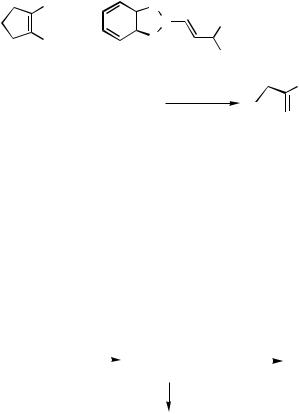
258 |
III Pd-CATALYZED CROSS-COUPLING |
G. REACTION WITH OTHER ELECTROPHILES
Although the cross-coupling reaction with organic halides has been studied predominantly, it has recently been discovered that trifluoromethanesulfonates (triflates) undergo a clean coupling with organoboron compounds, similar to organostannanes, aluminum, and zinc compounds. Triflates are valuable as partners for the cross-coupling reaction, in part due to the easy access from phenols or carbonyl enolates, which allow the selective formation of aryl or 1-alkenyl electrophiles. Although relatively strong bases such as aqueous NaOH and NaOEt in ethanol have been used for the reaction with organic halides, powdered K3PO4 suspended in THF or dioxane is sufficient enough to accelerate the coupling of 9-alkyl-9-BBN derivatives and 1-alkenyl- and arylboronates or boronic acids with triflates (Scheme 16).[41]
CO2Et |
O |
|
+ |
B |
OTBS |
OTf |
O |
|
|
C5H11 |
|
|
|
CO2Et
Pd(PPh3)4
K3PO4 

 C5H11 dioxane/85 °C
C5H11 dioxane/85 °C 
OTBS
y: 96%
Scheme 16
The coupling with triflates often fails to proceed because of the decomposition of catalysts, precipitating palladium black at an early stage of the reaction. Presumably, triphenylphosphine used as a ligand of palladium reacts with triflates to give phosphonium salts (Scheme 17). Addition of 1 equiv of lithium or potassium bromide is effective in preventing such decomposition of the catalyst, which is known to convert the labile cationic palladium species to organopalladium(II) bromide.[42]
ROTf |
Pd(0) . L4 |
[R-Pd(I)] [TfO]− . Ln |
LiBr |
R-Pd-Br . L2 |
|
|
|
|
|||
PPh3
[RPPh3]+ [TfO]− + Pd(0)
Scheme 17
The order of reactivity of halides and triflates for the cross-coupling reaction of boron reagents is I Br OTf Cl. Thus, the sequential cross-coupling reactions of 4- bromophenyl triflate with two 9-alkyl-9-BBN derivatives obtained from two different alkenes furnishes the unsymmetrically disubstituted benzene derivative (Scheme 18).[41]
